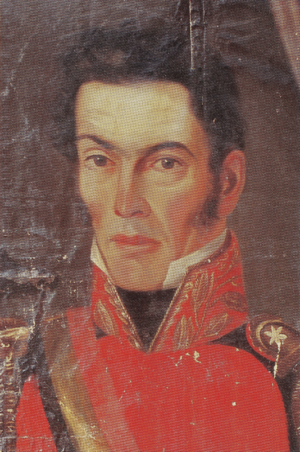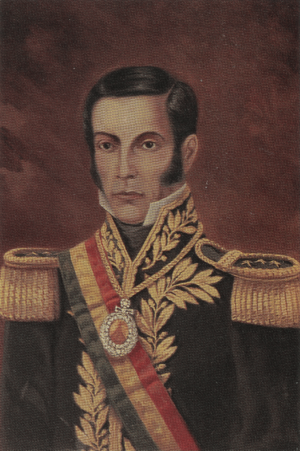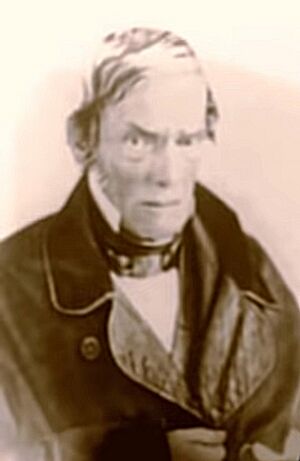José Miguel de Velasco facts for kids
Quick facts for kids
Eminent Republican
José Miguel de Velasco
|
|||||||||||||||||||||||||||||||||||||||||||||||||||||
|---|---|---|---|---|---|---|---|---|---|---|---|---|---|---|---|---|---|---|---|---|---|---|---|---|---|---|---|---|---|---|---|---|---|---|---|---|---|---|---|---|---|---|---|---|---|---|---|---|---|---|---|---|---|
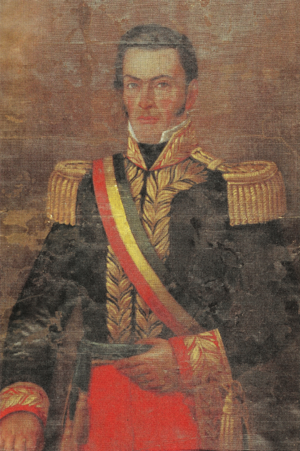
Portrait by Antonio Villavicencio, Museo de Charcas, Sucre
|
|||||||||||||||||||||||||||||||||||||||||||||||||||||
| 4th President of Bolivia | |||||||||||||||||||||||||||||||||||||||||||||||||||||
| In office 18 January 1848 – 6 December 1848 Provisional: 12 September 1848 – 6 December 1848 |
|||||||||||||||||||||||||||||||||||||||||||||||||||||
| Preceded by | Eusebio Guilarte (acting) | ||||||||||||||||||||||||||||||||||||||||||||||||||||
| Succeeded by | Manuel Isidoro Belzu (provisional) | ||||||||||||||||||||||||||||||||||||||||||||||||||||
| In office 22 February 1839 – 10 June 1841 Provisional: 22 February 1839 – 15 August 1840 |
|||||||||||||||||||||||||||||||||||||||||||||||||||||
| Vice President | Vacant (1839) None (1839–1841) |
||||||||||||||||||||||||||||||||||||||||||||||||||||
| Preceded by | Andrés de Santa Cruz | ||||||||||||||||||||||||||||||||||||||||||||||||||||
| Succeeded by | Sebastián Ágreda (provisional) | ||||||||||||||||||||||||||||||||||||||||||||||||||||
| In office 1 January 1829 – 24 May 1829 Acting |
|||||||||||||||||||||||||||||||||||||||||||||||||||||
| Preceded by | Pedro Blanco Soto (provisional) | ||||||||||||||||||||||||||||||||||||||||||||||||||||
| Succeeded by | Andrés de Santa Cruz (provisional) | ||||||||||||||||||||||||||||||||||||||||||||||||||||
| In office 2 August 1828 – 18 December 1828 Acting |
|||||||||||||||||||||||||||||||||||||||||||||||||||||
| Preceded by | José María Pérez de Urdininea (acting) | ||||||||||||||||||||||||||||||||||||||||||||||||||||
| Succeeded by | José Ramón de Loayza (acting) | ||||||||||||||||||||||||||||||||||||||||||||||||||||
| 2nd Vice President of Bolivia | |||||||||||||||||||||||||||||||||||||||||||||||||||||
| In office 24 May 1829 – 23 July 1835 Provisional: 24 May 1829 – 15 August 1831 |
|||||||||||||||||||||||||||||||||||||||||||||||||||||
| President | Andrés de Santa Cruz | ||||||||||||||||||||||||||||||||||||||||||||||||||||
| Preceded by | José Ramón de Loayza (provisional) | ||||||||||||||||||||||||||||||||||||||||||||||||||||
| Succeeded by | Mariano Enrique Calvo | ||||||||||||||||||||||||||||||||||||||||||||||||||||
|
|||||||||||||||||||||||||||||||||||||||||||||||||||||
| Personal details | |||||||||||||||||||||||||||||||||||||||||||||||||||||
| Born |
José Miguel de Velasco Franco
29 September 1795 Santa Cruz de la Sierra, Viceroyalty of the Río de la Plata (now Bolivia) |
||||||||||||||||||||||||||||||||||||||||||||||||||||
| Died | 13 October 1859 (aged 64) Santa Cruz de la Sierra, Bolivia |
||||||||||||||||||||||||||||||||||||||||||||||||||||
| Spouse | Mercedes Ibáñez | ||||||||||||||||||||||||||||||||||||||||||||||||||||
| Parents | Ramón Gonzales de Velasco Petrona Franco |
||||||||||||||||||||||||||||||||||||||||||||||||||||
| Signature | |||||||||||||||||||||||||||||||||||||||||||||||||||||
| Military service | |||||||||||||||||||||||||||||||||||||||||||||||||||||
| Allegiance | |||||||||||||||||||||||||||||||||||||||||||||||||||||
| Branch/service | |||||||||||||||||||||||||||||||||||||||||||||||||||||
| Rank | Major general | ||||||||||||||||||||||||||||||||||||||||||||||||||||
| Commands | 5th Batallion "Guías" Squadron |
||||||||||||||||||||||||||||||||||||||||||||||||||||
| Battles/wars |
|
||||||||||||||||||||||||||||||||||||||||||||||||||||
José Miguel de Velasco Franco (born 29 September 1795 – died 13 October 1859) was a Bolivian military leader and important politician. He served as the fourth president of Bolivia four different times: in 1828, 1829, from 1839 to 1841, and again in 1848. Velasco also held the position of vice president from 1829 to 1835 under Andrés de Santa Cruz.
Velasco was very active in the early days of Bolivian politics. He was part of two major times when the country was very unstable. He helped keep the presidential system going, often acting as president when needed. He was involved in several uprisings and had rivals like José Ballivián and Manuel Isidoro Belzu. After helping to remove President Santa Cruz in 1839, Velasco started his longest term as president. During this time, he created a new set of laws for the country.
Contents
José Miguel de Velasco: Early Life
José Miguel de Velasco was born on 29 September 1795. His birthplace was Santa Cruz de la Sierra, which was then part of the Viceroyalty of the Río de la Plata. Today, this city is in Bolivia. His parents were Ramón González de Velasco and Petrona Franco.
Velasco chose a career in the military. He first joined the Spanish royalist army. He served under Brigadier José Manuel de Goyeneche. However, he soon decided to support the patriots who were fighting for independence. He fought in the armies of José de San Martín and later Antonio José de Sucre. He took part in important battles like Ayacucho and Junín. After many years of fighting, Sucre promoted him to the rank of general because of his excellent military skills.
First Job: Prefect of Santa Cruz
After Bolivia became a new country, Simón Bolívar appointed Velasco as the first prefect of Santa Cruz. This happened on 11 November 1828, and Velasco started his job on 28 December. During his time as prefect, he announced that 15 February 1825 would be celebrated as the "day of independence from the Spanish government" in Santa Cruz.
Not much is known about his time as prefect. But it is noted that Velasco worked to make all people in the department citizens of the new republic. He also made trade easier, setting up ways to trade with other parts of the country.
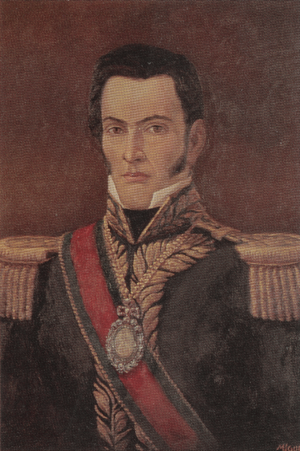
Short Time as Prefect of Chuquisaca
On 18 April 1818, there was a riot in the city of Chuquisaca. President Sucre was injured, and the prefect of Chuquisaca, José Miguel Lanza, died on 30 April. Because of this, Velasco was appointed prefect of the Chuquisaca Department for a short period.
Velasco's First Times as President
On 2 August 1828, President Sucre resigned because he was unable to continue his duties. A new group of ministers was chosen, with Velasco as the minister of war. Ten days later, the Congress chose Velasco to be the temporary vice president. He was put in charge of the country until the chosen president, Andrés de Santa Cruz, could arrive. Velasco's time in charge lasted until 18 December. Since Santa Cruz still hadn't arrived, the Congress met again. This time, they chose Pedro Blanco Soto as temporary president and José Ramón de Loayza as vice president.
When President Blanco took office on 26 December, he kept Velasco as the minister of war. This decision turned out to be important because just six days later, President Blanco was killed. Because of this, the Congress asked Velasco to be president again. A month into his term, on 31 January 1829, Velasco officially ended the Congress. He said they had gone "beyond their powers" and brought back the previous government. This meant Santa Cruz was once again asked to become president.
Becoming Vice President and a Big Change
Velasco handed over control of the country to Santa Cruz on 24 May. Then, Velasco himself became the vice president. For most of his time as vice president, he also served as the minister of war and navy. Two years later, on 15 July 1831, a special Congress met in La Paz. They officially recognized Santa Cruz as president and Velasco as vice president. At the same time, Velasco was given the rank of major general, and Santa Cruz became captain general. They both took their oaths of office the next day. Velasco's term as vice president ended on 23 July 1835, when Mariano Enrique Calvo was chosen to take his place. To honor his service, the Senate gave him the special title of "Eminent Republican."
After serving briefly as prefect of Santa Cruz again from 1836 to 1838, Velasco joined the War of the Confederation. He was the chief of staff for the armed forces. However, he became tired of Santa Cruz's plans. He felt Santa Cruz was putting Bolivia second in his goal to unite the state with Peru. After Santa Cruz's defeat in Yungay in January 1839, Velasco led a group of soldiers. He started a rebellion in Tupiza and declared that the Bolivian Republic was separating from the Peru-Bolivian Confederation on 9 February. Many people supported this rebellion. On 17 February, the government led by Vice President Calvo was removed. After five days of confusion, Velasco became the "provisional supreme head" of the republic in Potosí on 22 February.
Velasco's Third Term as President
Soon after becoming president, Velasco called for a special Congress in Chuquisaca. On 16 June, this Congress officially recognized him as the temporary president. During this time, the Congress worked on writing a new constitution. This new constitution was officially put into effect on 26 October 1839. It was the fourth constitution in Bolivia's history and the most liberal one yet.
Some important parts of this new constitution included:
- Ending the death penalty for political crimes.
- Setting up special courts and local governments.
- Giving people the right to petition the government.
One notable change was that the position of vice president was removed. If the president could not serve, the president of the Senate would take over. The vice presidency did not return until 1878, 39 years later.
Velasco's time as president was difficult. There were threats from outside the country and problems inside. On the western border, there was a constant threat of war with Peru, led by President Gamarra. This threatened Bolivia's independence. Meanwhile, supporters of the exiled Santa Cruz and General José Ballivián were plotting to overthrow Velasco's government. In July 1839, Ballivián and his soldiers rebelled. Velasco had to give presidential command to the president of Congress, José Mariano Serrano, while he personally led the army to stop the uprising. The rebellion failed, and Velasco showed mercy. He changed the death sentences for the rebellious soldiers and offered a general pardon to those involved.
A Coup and New Challenges (1841)
However, political plots continued. On 10 June 1841, Santa Cruz's supporters revolted in Cochabamba. They managed to capture Velasco and send him away to Argentina. The military government, led by Colonel Sebastián Ágreda, immediately called for Santa Cruz to return from exile. They gave control of the country to former vice president Calvo until Santa Cruz arrived. Soon after, Ballivián returned to Bolivia from Peru and opposed Santa Cruz's return. Meanwhile, Velasco, who had found safety in northern Argentina, gathered his army. He started another uprising in Tupiza and gained support in the capital, Sucre.
This situation turned Bolivia into a battlefield. Different presidential candidates fought for control. There was either no government or three different leaders at the same time: Velasco in Sucre, the group wanting Santa Cruz back in Cochabamba, and Ballivián in La Paz. During this chaos, Peru, led by Gamarra, was about to invade Bolivia. Finally, on 22 September, Ballivián overthrew the government led by Calvo. After five days of uncertainty, Ballivián became president on 27 September.
The Important Battle of Ingavi
On 1 October, just four days after Ballivián became president, Peruvian forces began to enter Bolivian territory. At this point, Ballivián had not yet fully gained control of the country. The civil war gave Gamarra a chance to take over Bolivia. However, in a display of national unity, Velasco decided to put aside his political goals. He ended his rebellion and gave control of his troops to Ballivián. With Velasco's help, Ballivián won a great victory in the Battle of Ingavi on 18 November. This battle decisively defeated the Peruvian army and resulted in the death of Gamarra. After the victory at Ingavi, Velasco chose to live in exile in Argentina, settling in Yavi.
Velasco's Last Time as President
Between late 1847 and early 1848, Velasco was again at the center of another very unstable time in Bolivia. In October 1847, the Prefect of Santa Cruz, Manuel Rodríguez Magariños, was removed from his position. General Francisco Bartolomé Ibáñez, from Santa Cruz de la Sierra, declared Velasco president. Throughout the month, more declarations supporting Velasco's return happened in other cities like Cinti, Potosí, Sucre, Tarija, Chichas, and Mizque. By the end of the month, a revolution with 3000 men had started. However, Ballivián quickly stopped it due to mistakes by the rebel leaders. Still, many people across the country continued to support Velasco.
On 27 November, Velasco was declared "legal president of Bolivia" in the town of Mojo. By 17 December, the 10th Battalion had rebelled in La Paz. They formed an army of over 2000 men, led by Colonel Manuel Isidoro Belzu. The situation was out of control. Seeing what was happening, President Ballivián resigned on 23 December to avoid being violently overthrown. In the following days, the entire army declared support for Velasco. After ten days in office, the government led by Ballivián's successor, Eusebio Guilarte, was overthrown. Sixteen days passed with uncertainty until 18 January, when Velasco took the oath of office in Moraya.
Velasco's new government ruled by special orders until August. Then, the Extraordinary Congress met under the 1839 Constitution. On 12 September, they elected Velasco as provisional president. Velasco's government did not last long. Belzu, who was Velasco's own minister of war, had political ambitions. He started a rebellion in Oruro. On 12 October, Belzu was declared president by his supporters. Velasco was forced to give control of the government to the president of the Extraordinary Congress, José María Linares. Velasco then gathered his forces in Potosí. Velasco and Belzu fought in small battles for several months, with wins for both sides. Finally, on 6 December, Velasco was defeated at Yamparaez.
After Yamparaez, there was an attempt to bring Velasco back to power. Velasco's forces managed to take Tarija, but they were defeated in Potosí and Cochabamba. With that, Velasco lost power for the last time. He went back into exile in Argentina. In 1854, he and Linares made one last attempt to become president, but they were defeated at Mojo and fled across the southern border again.
Later Life and Legacy
On 11 September 1855, the government of Jorge Córdova, who was Belzu's successor and son-in-law, allowed Velasco to return to Bolivia. They even paid for his travels and gave him a government pension. José Miguel de Velasco died in Santa Cruz de la Sierra on 13 October 1859. He was the first president to wear the historic presidential medal, a symbol of the presidency. He was also the first president from Santa Cruz.
Images for kids
See also
 In Spanish: José Miguel de Velasco para niños
In Spanish: José Miguel de Velasco para niños


